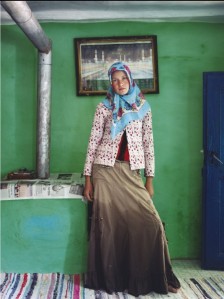“To photograph people is to violate them, by seeing them as they never see themselves, by having knowledge of them that they can never have; it turns people into objects that can be symbolically possessed. Just as a camera is a sublimation of the gun, to photograph someone is a subliminal murder – a soft murder, appropriate to a sad, frightened time.”
–  Susan Sontag, On Photography
Susan Sontag, On Photography
The usage of still photography in ethnographic fieldwork tends to be perceived as a challenge to the disciplinary boundary mostly because it enables anthropologists to oscillate between what Margaret Mead would define as scientific fidelity and aesthetic sensitivity. What I find inspiring in this duality of still photography as an ethnographic instrument is related firstly to a sort of honesty in recording superficial aspects of a subject and further in recreating the real image of an object, in representing what things really are (this-is-how-it-was), in other words, reclaiming the authenticity of cultural representation.
On the other hand, it presupposes, as a (visual) medium, a linkage to the aesthetic style which empowers the observer to control the aesthetic spectacle, or the cinema of attractions, meaning that photography becomes a visual metaphor: it communicates not only the visual truth but also it´s capable of unravelling the meanings of cultural beings. By representing this-is-how-it-is implies an expressive approach that can conflict with the purposes of the photographic use: the observer employs photography in order to explore and document what lies before his lens not to overwhelm the content. But to another extent, the aesthetic tendency of the photographer (ethnographer) can fulfill and substantiate the nature of things. But how much self-expression should the (photo)ethnographer include in the photographic process in order not to subliminally murder, as Sontag put it, the casual complexities of a culture/community?
In October, 2012, at the Museum of Ethnography in Budapest I had the chance to attend an exhibition entitled „Casa Mare” (translated “The Big House”) by Frank Gaudlitz[i], which I believe is related to our discussion on this challenge that photography is subjected to, namely, to reconcile the medium for the visual truth with the expressive representation and visual interpretation of the same truth. Furthermore, it reflects an example of how to stage through photography an ethnographic setting.
This exhibition comprises a collection of color photographs taken by Gaudlitz in Eastern and South Eastern Europe, such as Transylvania, Maramureș and Dobrudjia in Romania, Southern Hungary, Republic of Moldova and Vojvodina in Serbia. What defines them as ethnographic material is that they present people full-figure, in the most prestigious room of their homes, surrounded by different objects, pictures in the background that constitute interiors of everyday life, and in the same time, illustrate their cultural identity and social status. I find this exhibition relevant for a further discussion because although the photographer tried to capture realistically his subjects in their authenticity, such as the natural light, the colors of their homes, their personal objects, actually the photographs were staged in the sense that Gaudlitz lets his subjects prepare for his arrival, they have put their best clothes and had the chance to choose and arrange their room as they wish. The issue of staging is two-folded because on one hand, the purpose of the photographs is not shadowed by this so to say ‘preparation’, they are still vehicles of cultural identity, reflecting the specificities of a certain culture and modernity’s distortions. But on the other hand, how much of what is prepared reflects the everyday life and the realism or the casual complexities of their culture?

I’m happy you pointed out Sontag’s ambivalence towards photography, it comes through not only in her critique of Leni R.
Gaudlitz’s project reminded me of an excellent project that we could discuss in class, Mandrie si Beton: www. mandriesibeton.ro
Reblogged this on Visual Anthro@CEU Blog.
I was meaning to write about Frank Gaudlitz’s Casa Mare as well, since I saw the exhibition back in September. I do agree with your point and questioning about the issue of staging and authenticity. To me, the photographs conveyed the same feeling of overly staged and preparedness… I am wondering if Gaudlitz as the photographer gave full independence to his subjects to choose the clothes, the room, the objects surrounding it… or were they all his choice for the photographs to be more interesting or colorful or eye-catching. If so, what does this tell us about authenticity of representation of these people’s everyday lives?